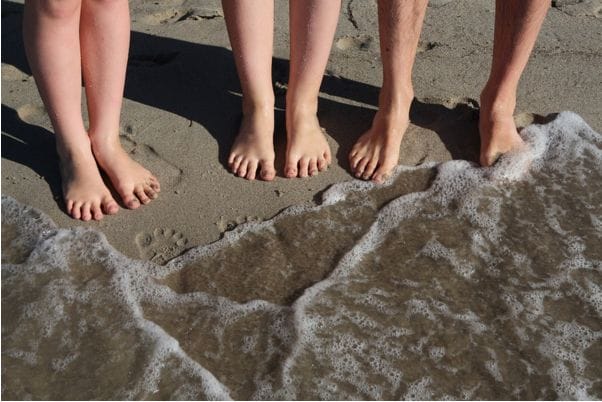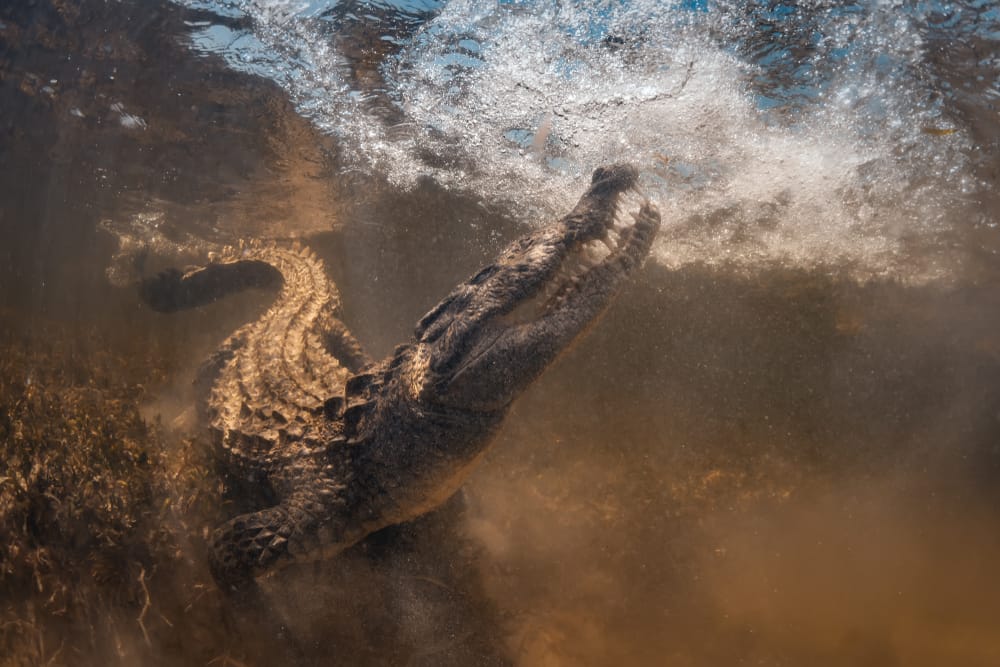There are lots of animals that simply don’t deserve their dangerous reputation. Did you know, for example, that sharks barely kill anyone each year, even though they’re notorious for apparently doing so? Similarly, the Goliath bird-eating spider is a terrifying beast indeed, but it’s not even remotely dangerous to humans; it can’t do much more than sting you with the force of a wasp, and it mostly subsists on worms, frogs, and other amphibious animals. The animals on this list aren’t like these two. They’re legitimately dangerous, and if you encounter them, you’d better make yourself scarce. Here, in no particular order, are 20 animals you won’t want to meet on your travels.
1. Sharks

Depending on your travel location, one thing many enjoy when going on holiday is swimming in the ocean, however, you should ensure all safety measures are in place before casually opting to take a swim. Sadly, shark attacks do happen. As this article goes live, today, we see such an incident that happened in Australia. With that mentioned, it’s rare that a shark attack happens, and it depends on the ocean you are swimming, but it’s also important to remember that these predatory creatures can attack humans.
2. Lions

Lions look and sound fierce, and they earn that reputation. Of course, lions rarely attack humans if their territory is not encroached on, but as human villages get closer to lion’s dens and homes, attack frequencies increase. Lions are known to be savage and ruthless hunters, and that’s definitely the truth; there’s no unearned reputation of danger here. Unfortunately, these majestic creatures are also the victims of canned hunts.
3. Grizzly bears

The grizzly bear, also called the brown bear, is an incredibly dangerous animal. Around 96% of bear attacks in the state of Alaska between the years of 2000 and 2016 involved grizzlies, and it’s only getting worse as humans encroach into bears’ habitats. As with many animals, human proximity often causes grizzlies’ aggression, but they’re incredibly dangerous nonetheless, so stay away from them.
4. Tigers

Tigers aren’t called apex predators for no reason. They’re the very top of the food chain, and if that chain happens to contain you, then they won’t hesitate to attack. These sleek, beautiful cats will tear you limb from limb if they feel like you’re threatening them or like you’re easy prey. Again, human encroachment on their habitats causes a lot of their aggression, unfortunately.
5. Sydney funnel web spiders

Unlike the Goliath bird-eating spider, the Sydney funnel web spider is absolutely dangerous and you should stay away from it. This spider has an incredibly potent venomous bite that will cause excruciating pain, vomiting, and even coma in some patients if not treated. Funnel web spiders have lethal bites, so if you’re bitten by one, seek medical attention immediately.
6. Crocodiles

As you’d imagine, crocodiles are pretty dangerous. There’s a good reason these creatures have barely evolved since the days of the dinosaurs; they’re well-suited to their environment, and like tigers, they’re apex predators, capable of wrecking anything that swims into their river. The crocodiles living in the Nile kill around a thousand people per year, so don’t go swimming in the Nile unless you know for a fact it’s absolutely safe.
7. Tsetse flies

Here, we have an animal that’s dangerous more by the disease it carries rather than its bite or its claws. The tsetse fly carries a nasty disease called trypanosomiasis, otherwise known as African sleeping sickness, which is transmitted via a parasite present on the infected fly. That disease is fatal for anyone that doesn’t get treated immediately, but thankfully, recent medical advances within sub-Saharan Africa have made it so that the number of global cases per year is less than a thousand as of 2018.
8. Tapeworms

If you eat improperly-cooked pork that’s infested with tapeworms, you’re going to get an infestation yourself. These worms aren’t particularly dangerous in the West, where we can easily access treatment for them, but in developing countries, they are frequently fatal due to causing epileptic fits. Tapeworms are one of the most common causes of death by food-related illness in the world, so make sure you prepare your pork carefully next time you’re eating it.
9. Hippopotamuses

You wouldn’t think the hippo was particularly dangerous to look at it; after all, they look like gentle giants, with their rounded faces and rhino-like bodies. However, hippopotamuses (or hippopotami) can be extremely aggressive and violent, causing thousands of deaths each year. Again, it’s important to make sure you don’t venture near hippo habitats if you find yourself near one, because they’re intensely territorial and will attack you on sight if they feel you are a threat.
10. Box jellyfish

If you’ve ever heard tales of people being paralysed then killed by a jellyfish sting, they were probably talking about the box jellyfish. They are by far the deadliest jellyfish in the sea, and many marine biologists consider them to be one of the sea’s most dangerous animals, full stop. If you’re stung by a box jellyfish, you can expect paralysis, potential cardiac arrest, and possibly even death. They’re found in the Pacific Ocean, so don’t swim close to them if you want to stay safe.
11. Deathstalker scorpions

Despite having a name right out of the Fallout franchise of video games, the deathstalker scorpion is very real and very dangerous. Scorpions sting by whipping their tails over their head, delivering a potent dose of venom from the spiked tip of the tail. The deathstalker is the world’s most venomous scorpion, and if you’re stung by one, you could die if you don’t seek medical attention. They’re also very small and hard to spot in their natural habitat, so be on the lookout.
12. Poison frogs

When we talk about poison frogs here, we’re specifically referencing the Colombian golden poison frog, which secretes a poison (not a venom, as it’s ingested, not injected) called batrachotoxin. This happens because the frog’s diet consists mainly of ants that carry this toxin, but the frog itself never actually gets poisoned by the ants, instead secreting the toxin through its own skin and fending off predators that way. If you see a golden frog, do not touch it under any circumstances.
13. African buffalo

It’s pretty obvious that African buffalo are going to be dangerous just by looking at them. These imposing creatures have huge horns on their heads, as well as a physically imposing size and an obviously aggressive posture. Buffalo have been known to raid farmers’ crops, causing conflict between the animal and its human neighbours and leading to far too many deaths and injuries. Steer clear (no pun intended) of African buffalo if you’re going somewhere they live.
14. Fire ants

Fire ants live mainly in the southeast of the USA, mostly in states like Florida and Georgia. They’re extremely aggressive insects that come in huge numbers, seizing their victims and injecting a powerful toxin. For most people, fire ant stings will come across as immensely painful, but they aren’t likely to be deadly. If you’re particularly sensitive to the toxin or the pain, however, you can go into shock and die, and if you’re stung by many ants at once, the pain can grow unbearable.
15. Dogs

Dogs may be humankind’s best friend, but they’re also one of its worst nightmares in the wrong circumstances. Bites from rabid dogs are estimated to kill around 25,000 people around the world each year. Granted, that’s only dogs with rabies; most dogs are fairly placid and won’t hurt you unless you provoke them (which you should not do). However, if a dog is gripped by rabies, it will not hesitate to attack you, so make sure you put some distance between you and the dog quickly if that’s the case.
16. Elephants

Despite their incredible intelligence and relatively docile demeanour, elephants can also be very aggressive and dangerous. If they’re protecting their herd, they can be territorially violent, and if they feel they’re being abused by their captors, they have the potential to lash out. As you can imagine, a creature the size of the elephant will have no problem killing a human, and although most captive elephants are friendly, humans would do well to remember they are creatures worthy of respect (as are all animals).
17. Assassin bugs

You might know assassin bugs by their altogether more horrifyingly cute moniker of “kissing bugs”. They got this name because they often pierce human lips and mouth tissue with their long proboscis, causing a bite that can reasonably be described as “screamingly painful”. Despite their name, most assassin bugs don’t actually cause death, but a handful of species carry a disease known as Chagas disease, which can cause organ failure.
18. Freshwater snails

Just like assassin bugs and tsetse flies, freshwater snails carry a disease, and it has caused the deaths of countless people. The disease in question is schistosomiasis, and it causes crippling abdominal pain, as well as causing you to pass blood in your urine. For most people who catch the disease, it’s not fatal, but since freshwater snails occur in many underdeveloped countries, the fatality rate is sadly very high.
19. Saw-scaled vipers

Despite more culturally ubiquitous snakes like cobras and Boa constrictors taking up more of the public imagination, the most lethal snake in the world is actually the saw-scaled viper. This beast is small, but that doesn’t make it less deadly; it kills a lot of people, and those it doesn’t kill often require limb amputations because of the quick spread and sheer potency of the snake’s toxin.
20. Honey badgers

You’ve probably seen the memes about honey badgers, but the truth is they will only usually attack if they feel they, their mate, or their children are threatened. Of course, the honey badger itself gets to decide when it feels threatened, so attacks are relatively frequent. Honey badgers are also extremely smart; they’ve been known to devise methods of escaping enclosures when they feel they’re better-placed elsewhere.
21. Black mambas

The black mamba is not black; it’s actually brown, so its name is somewhat misleading. However, the reputation it has for being incredibly dangerous is definitely earned. With top speeds of up to 12 miles an hour, it’s one of the world’s fastest snakes, and it carries around 20 drops of venom in each one of its fangs. To put that number into perspective, the black mamba can easily kill a human being with just two drops of venom. It lives in Africa.




